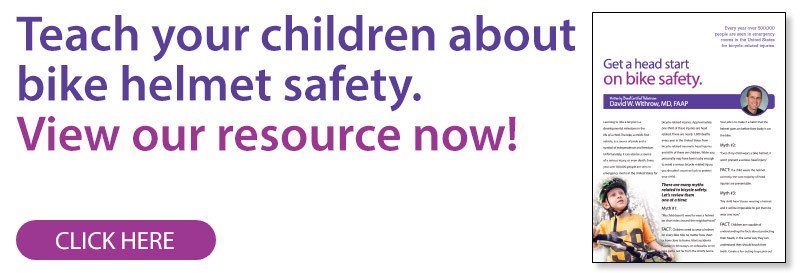When it comes to bike safety, there’s never a wrong time to get a head start on protecting your child from injury as they first begin to adventure into the world. Learning to ride a bicycle is a developmental milestone in the life of a child. A bike is a child’s first vehicle, a source of pride, and a symbol of independence and freedom. Unfortunately, it can also be the cause of serious injury or death.
Every year, over 500,000 people are seen in emergency rooms in the United States for bicycle-related injuries. Approximately one-third of those injuries are head related. There are nearly 1,000 deaths every year in the United States from bicycle-related traumatic head injuries, and 60% of them happen to children.
While you might have been lucky enough to avoid a serious bicycle-related injury when you were younger, you shouldn’t count on the same luck to protect your child. Bike safety is an important part of providing your child their first taste of independence and exploration. While protective equipment like helmets have become much more commonplace nowadays, there are still many myths related to bicycle safety. Let’s review them one at a time.
1. Children don’t need to wear helmets on short rides
The first common myth is that children don’t need to wear helmets on just short rides around the neighborhood. While almost everyone has done it, it is not advisable to skip wearing a helmet ever, even if it’s just for a quick spin around the neighborhood. Children need to wear a helmet on every bike ride, no matter how short or how close to home it will be. Most accidents happen in driveways, on sidewalks, or on bike paths not far from a child’s home. As a parent, your job is to make it a habit for your child to put on their helmet before they hop on their bike.
2. Helmets don’t prevent serious head injuries
The second myth is that helmets don’t prevent serious head injuries. This is simply not true. If a child wears a helmet correctly, the vast majority of head injuries are preventable. Helmets have been designed and tested to prevent head injuries, and, if they are worn properly, they can keep your child safe.
3. If they haven’t been wearing one, they won’t start
The third common myth is that children who haven’t been wearing their helmets can’t begin to follow the habit of wearing them. Children are capable of understanding the facts about protecting their heads, in the same way they can understand why they should brush their teeth. Create a fun outing to pick out a helmet for your child, then they can choose which one they want. Letting your child help pick out their helmet will help to ensure it fits well and is comfortable.
As parents, it’s important to establish helmet habits early. It’s never too early to begin the healthy habit of wearing a helmet. Children should start wearing a helmet as soon as they begin riding tricycles, or if they are passengers on the back of an adult bike. If children learn to wear helmets early, they are more likely to continue the helmet habit for a lifetime, and they’ll teach your future grandchildren to wear helmets, too.
Setting an Example
Since children learn best by observing, parents ought to make it a habit to wear helmets as well. Whenever you ride your bike, make a point to wear your helmet. Children are always watching, so displaying the safe habit of wearing a helmet is an important step in getting your child to wear theirs. Planning a family bike ride and making sure everyone is wearing their helmet can also reinforce the message. The single most important factor influencing children to wear a helmet is riding with an adult who wears one, too.
Talking with your child about the importance of bike safety is of the utmost importance. Make it a priority to let your child know that bikes are vehicles and not toys, and it is important to always use them safely. Let your child know how much you love and value their safety and health. Telling them about the risks of brain injuries and the permanent damage that result from them is also important. Kids can handle knowing such things, and it will make them more cautious.
Riding a bike is fun for a child, and it can be even more fun if it is safe. Remember, more than 600 children die annually from bike-related injuries, and other children experience serious head injuries. Helmet use should be a non-negotiable part of your child’s bike riding. The rule should be clear: no helmet, no bike. When it comes to bike safety, enforcing and encouraging helmet safety is the most important part of keeping your child safe from serious injuries and enjoying their adventures.
